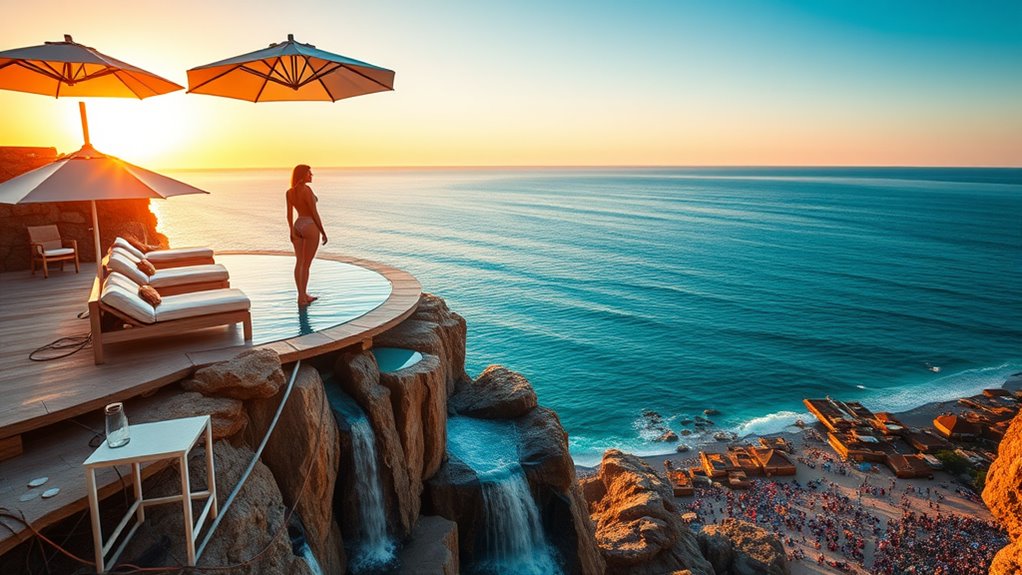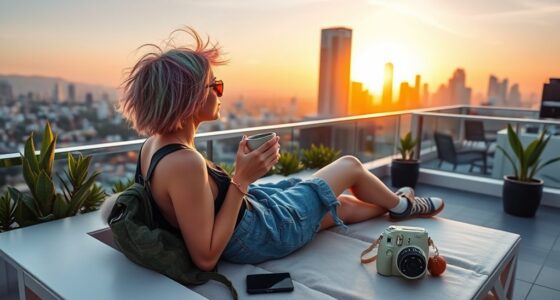Instagram and social media often create a glossy, curated version of travel that can spark your wanderlust but also set unrealistic expectations. Stunning photos and influencer stories showcase picture-perfect moments, yet they can hide the reality of crowded sites or superficial experiences. While social media can inspire exploration, it can also distort authenticity and fuel FOMO. To understand how to navigate these effects, explore how visual content shapes perceptions and the future of travel influences.
Key Takeaways
- Instagram often showcases curated, aesthetically pleasing images that can distort travelers’ expectations versus real experiences.
- Authentic user-generated content provides a more genuine view, but social media trends can still promote superficial impressions.
- Viral destinations may become overcrowded, leading to environmental strain and loss of authenticity, contrasting with the tranquil reality.
- Influencer-driven content emphasizes visual appeal over local culture, impacting perceptions of authenticity and depth of experience.
- The pursuit of “Instagrammable” spots can overshadow meaningful cultural interactions, creating a gap between online images and real travel moments.
The Power of Visual Content in Travel Inspiration
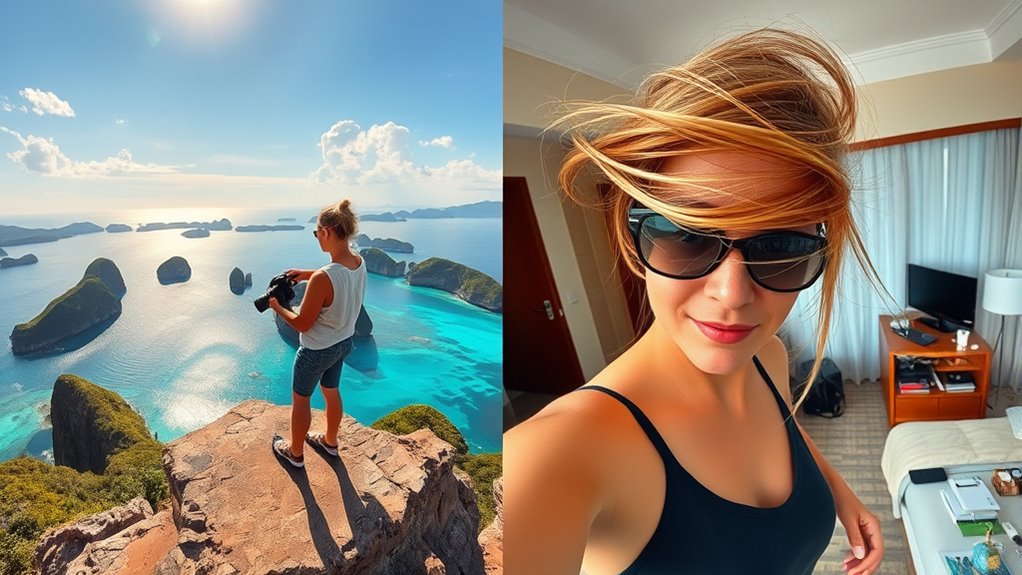
Visual content has become a powerful tool for sparking travel inspiration, especially on platforms like Instagram. It taps into cultural nuances and uses visual storytelling to evoke emotions like FOMO, making destinations seem authentic and desirable. When you see high-quality photos and videos, you’re more likely to imagine yourself there, fueling your curiosity and travel plans. Over 86% of people and 92% of Gen Z report becoming interested in a destination after seeing user-generated content. Instagram’s focus on rich imagery, with 65% of posts being photos, amplifies this effect. With features like location tags and Reels, your travel dreams are easily inspired through compelling visuals. This cycle of sharing and viewing creates a powerful influence on how you perceive and decide on your next adventure. UGC acts as a primary source of inspiration, and its impact continues to grow in shaping travel decisions. Additionally, the use of visual storytelling enhances emotional connections, making the experience more memorable and motivating viewers to explore new destinations.
How Influencers Shape Our Travel Dreams
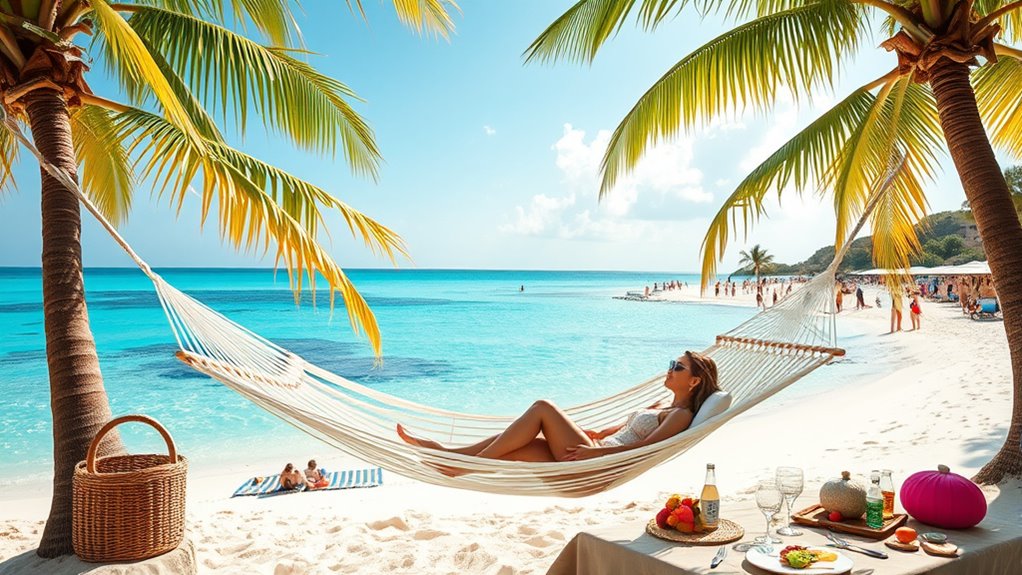
Influencers considerably shape your travel dreams by sharing curated experiences, stunning visuals, and authentic stories that make destinations feel both desirable and attainable. Their content taps into Travel FOMO, making you want to visit places immediately to avoid missing out. Influencer credibility plays a key role, as authentic storytelling and curated itineraries help you visualize complete trips, boosting destination appeal. Younger travelers, especially Millennials and Gen Z, are most influenced, often choosing destinations based on Instagrammable qualities or influencer recommendations. This creates a cycle where curated images and narratives elevate certain spots, often turning them into must-visit hotspots. As influencers showcase idealized versions of travel, they shape your perception of what’s possible, exciting your travel dreams and fueling your desire to explore these visually appealing destinations. 73% of travelers report influencer recommendations have led to booking decisions, demonstrating the tangible impact of influencer content on travel planning. Additionally, the rise of cultural content on social media platforms emphasizes the importance of authentic and relatable storytelling in shaping travel preferences.
The Impact of User-Generated Posts on Destination Choices
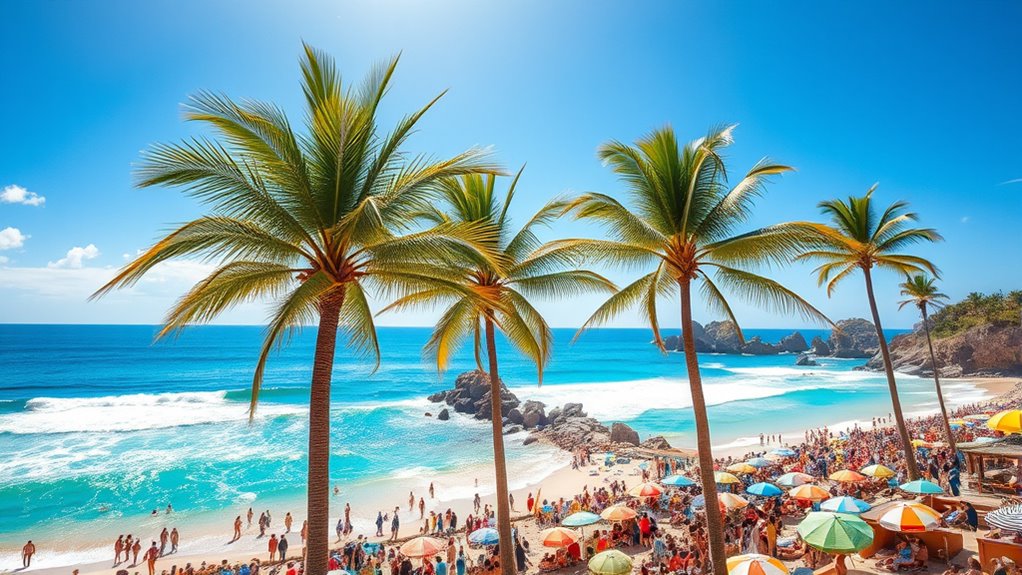
You’re influenced by real travelers’ posts more than you might realize, as authentic content often sparks your interest and trust. Stunning visuals and genuine stories shape how you perceive destinations and motivate your trips. In fact, user-generated posts can be just as powerful—if not more—than traditional marketing in guiding your travel choices. Additionally, the effectiveness of eye patches demonstrates how consistent, genuine care can lead to noticeable improvements, much like how authentic travel content can influence your perceptions over time.
Authenticity Drives Engagement
Authenticity in user-generated content (UGC) substantially boosts engagement because travelers trust real experiences more than polished advertisements. When you see genuine posts, you’re more likely to feel connected and inspired to visit a destination. This trust is essential, especially as user privacy concerns grow and algorithm bias can skew content visibility. To maximize impact, consider these key points:
- Authentic posts create a realistic impression, increasing desire to visit.
- Sharing genuine experiences fosters trust and positive attitudes.
- Despite algorithm bias, authentic content often reaches more viewers because it resonates personally.
- The rapidly expanding industry worth, projected to reach $32.6 billion by 2030, underscores the importance of authentic content in capturing consumer attention and driving destination choices.
- Incorporating user engagement strategies that emphasize authenticity can further enhance the reach and impact of travel-related content.
Visual Content Inspires Travel
Authentic user-generated content not only builds trust but also sparks your imagination about potential travel destinations. When you see travel photography showcasing scenic landscapes, it fuels your desire to visit those places. Social media platforms like Instagram and TikTok are filled with real experiences, inspiring you to explore new destinations. With over 729 million travel-related posts on Instagram, it’s clear how visual content drives discovery. Location tags boost engagement by up to 79%, making it easier to find hidden gems. Seeing friends or strangers share their adventures influences your decisions—whether it’s booking a hotel after spotting a TikTok video or planning a trip to a beach or park featured in a post. These vibrant images and videos turn wanderlust into actual plans. Additionally, a significant percentage of travelers now rely on social media for travel inspiration, with 35% globally and 53% among Gen Z turning to these platforms for ideas for travel inspiration.
Influencers Shape Perceptions
Influencers have become powerful voices in shaping how travelers perceive destinations, often serving as trusted sources through their endorsements and personal stories. Their influencer branding influences your destination choices by providing social proof and inspiring trust. When you see compelling content, it can sway you in these ways:
- You’re more likely to contemplate a location if an influencer’s personal story or endorsement appeals to you.
- Popular hashtags and influencer posts increase a destination’s visibility, creating a “must-visit” effect.
- The curated images and videos shape your expectations, sometimes leading to overspending or chasing “Instagrammable” experiences.
- The trust placed in influencer recommendations is supported by research showing that social proof significantly impacts travel decision-making.
- Additionally, the prominence of WWE Raw’s financial impact and the success stories of top entertainers influence perceptions of wealth and luxury destinations, further shaping travel aspirations.
The Rise of Viral Destinations and Overtourism
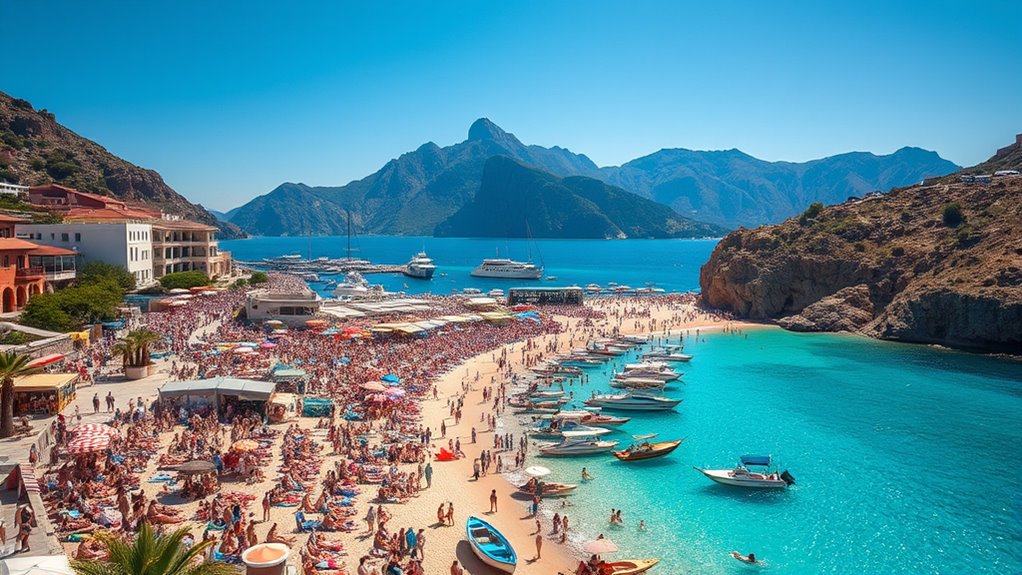
The rise of viral destinations driven by social media has transformed popular travel patterns, often leading to overcrowding and environmental strain. Viral trends like TikTok’s soaring posts about Kyoto, Osaka, and South Africa have skyrocketed their popularity, drawing massive crowds during peak seasons. These social media-driven surges challenge sustainable tourism efforts, as local infrastructure struggles to keep up with the influx. Iconic spots like Dubai, New York City, and Paris remain top trending locations, while niche hashtags amplify specific destinations’ visibility. However, this rapid exposure can cause environmental degradation and loss of authenticity, pressuring authorities to implement visitor management measures. To balance the benefits of viral exposure with the need for sustainability, travelers and destinations must prioritize responsible tourism practices and limit overtourism’s negative impacts. Emerging destinations like South Africa are experiencing a notable rise, highlighting the importance of managing growth responsibly. The phenomenon of overtourism underscores the need for strategic planning to preserve the unique character and environment of these popular sites.
The Reality of Curated vs. Authentic Travel Experiences
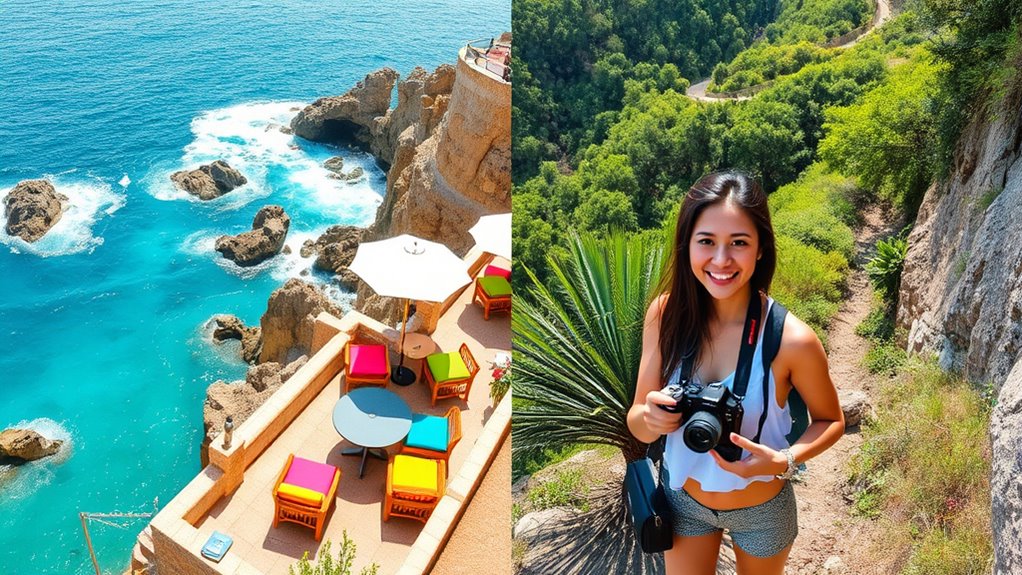
You often expect travel experiences to match the perfect images you see online, but reality can be quite different. Curated content emphasizes aesthetics and staged moments, which can make authentic local culture feel secondary or even lost. As a result, your trips might feel more like photo opportunities than genuine explorations of the destination. Incorporating diverse and creative representations of local environments can help bridge the gap between curated images and authentic experiences.
Curated Content Expectations
While curated travel content on platforms like Instagram often showcases stunning, idealized scenes, it rarely reflects the full reality of a trip. You might find yourself planning your travels around Instagrammable spots, influenced heavily by destination branding and influencer content. This creates inflated expectations that can distort what authentic travel truly is. Consider these points:
- Many travel plans revolve around famous photo locations, often at the expense of deeper cultural experiences.
- Influencers set aspirational standards that emphasize perfect visuals over genuine engagement.
- The pressure to appear as if every moment is picture-perfect can lead you to prioritize aesthetics over authentic travel experiences.
This curated content shapes your perceptions and influences your destination choices, often leading to a disconnect between expectation and reality.
Authentic Experience Challenges
Curated travel content often paints an idealized picture of destinations, making it challenging to discern authentic experiences from staged images. You may find it hard to spot genuine cultural authenticity amid carefully selected photos that hide local struggles and imperfections. Social media prioritizes visually appealing content, which often sidelines meaningful local interactions, replacing them with superficial encounters designed for the camera. This focus can lead to a diluted understanding of a place’s true essence, as travelers follow influencer itineraries rather than engaging directly with local communities. The pressure to produce perfect social media moments encourages you to prioritize appearance over genuine immersion, often resulting in missed opportunities for authentic cultural exchange. Additionally, decluttering your digital space can help you focus on meaningful experiences rather than superficial content, fostering a more genuine connection with the places you visit. Ultimately, this disconnect diminishes the richness of your travel experience.
Navigating the Influence of Social Media on Travel Satisfaction
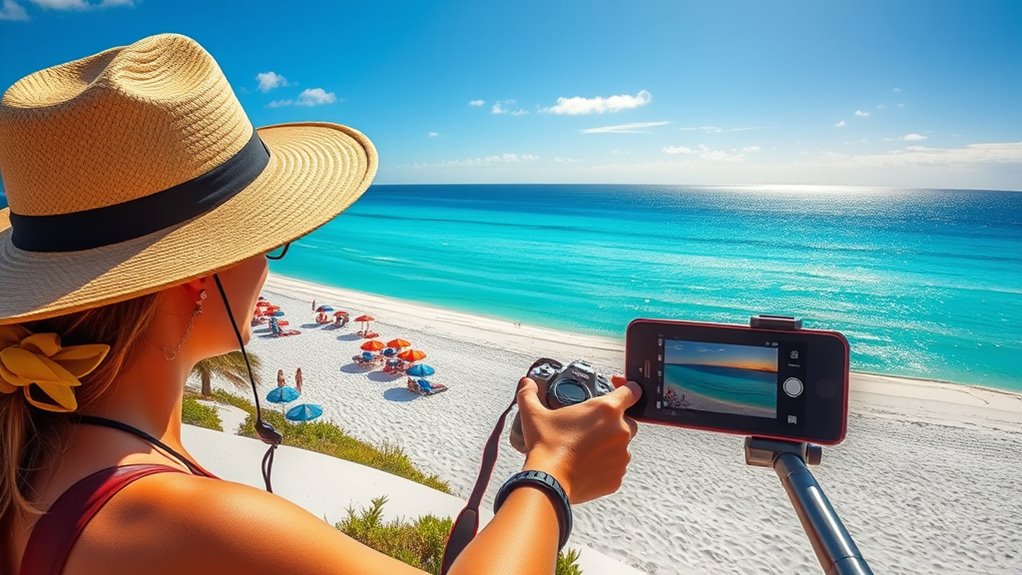
Social media has become a powerful tool that shapes how travelers choose and evaluate their experiences, often setting expectations before they even arrive at a destination. To navigate this influence, consider these key points:
- Recognize that social media impacts cultural influence, shaping your perceptions of a place’s authenticity and local vibe.
- Use social content to aid budget planning by discovering affordable options that match your travel style.
- Be mindful of FOMO and peer validation, which can skew your satisfaction if you chase perfect posts rather than genuine experiences.
- Incorporate positive thinking techniques to maintain a healthy mindset and appreciation for your unique journey, rather than comparing it to curated social media portrayals.
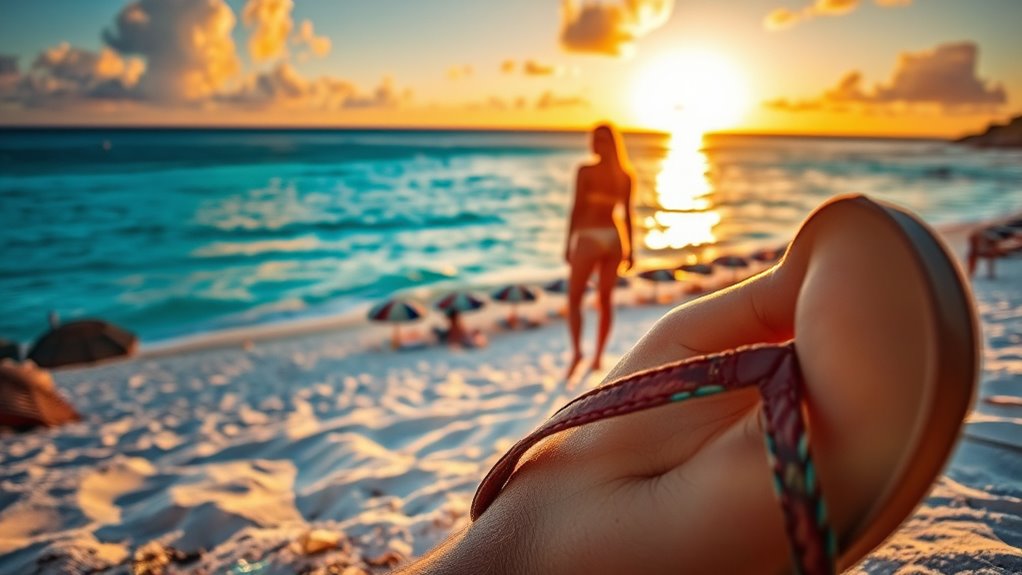
Advancements in technology are transforming how travelers discover and choose their destinations, with AI-driven personalization leading the charge. Soon, your travel plans will be tailored precisely to your preferences through AI-powered recommendations, chatbots, and predictive analytics, making each trip more unique. As social media continues to influence travel inspiration with short-form videos and authentic UGC, you’ll find it easier to connect with genuine experiences. Additionally, understanding relationship dynamics can help travelers navigate interactions with locals and fellow tourists more effectively. However, future trends also highlight a shift toward digital detox and offline adventures, encouraging you to disconnect from screens and immerse yourself fully in local culture. Travel brands will focus on creating community-centered experiences, like “Tribe Travel,” fostering meaningful bonds. These trends will shape a future where your wanderlust balances digital inspiration with real-world connection and personal growth.
Frequently Asked Questions
How Do Social Media Filters Alter Travelers’ Perceptions of Destinations?
You see, social media filters cause filter distortion that alters your perception bias of destinations. They make places look more pristine, vibrant, and perfect than reality. This can lead you to develop unrealistic expectations, focusing more on aesthetics than authentic experiences. When reality doesn’t match these idealized images, you might feel disappointed or misled. Filters shape your perceptions, often skewing your view and influencing your travel decisions based on an illusion rather than the true destination.
What Ethical Concerns Arise From Influencer Marketing in Travel Promotion?
You should be aware that influencer marketing in travel raises authenticity concerns and questions about influencer transparency. Many influencers don’t clearly disclose sponsored content, which can mislead followers and erode trust. This lack of transparency often results in viewers questioning whether recommendations are genuine or paid promotions. Ethical issues also emerge when influencers glamorize destinations without considering environmental or social impacts, risking exploitation and damaging their credibility with conscientious audiences.
How Can Travelers Distinguish Between Authentic and Curated Travel Content?
Did you know that 84% of consumers trust user-generated content more than polished brand posts? To spot authentic travel content, look for genuine moments and unfiltered visuals rather than overly curated images. Focus on photo authenticity—real, imperfect shots often reveal true experiences. Trust content from micro-influencers or local voices, as they tend to share honest insights. If it feels relatable and spontaneous, you’re likely viewing authentic travel stories, not just a polished façade.
What Are the Environmental Impacts of Viral Travel Destinations?
Viral travel destinations often face environmental impacts like overuse of water, habitat destruction, and increased waste. When you visit, you might unintentionally contribute to these issues if sustainable tourism isn’t prioritized. To help, choose eco-friendly practices like respecting local ecosystems, supporting sustainable accommodations, and minimizing resource consumption. Your mindful travel can reduce pressure on fragile environments, ensuring these beautiful spots remain vibrant and healthy for future visitors.
How Can Destinations Manage Overtourism Driven by Social Media Popularity?
Did you know that popular destinations see visitor numbers double during social media peaks? To manage overtourism, you need to focus on community engagement and promote sustainable tourism. Limit visitor access during peak times, develop lesser-known attractions, and encourage off-season travel. Collaborate with local communities to ensure tourism benefits everyone, and use social media to educate travelers about responsible behaviors, alleviating pressure on crowded sites.
Conclusion
As you scroll through endless travel posts, remember that 73% of travelers feel pressured to visit popular spots seen online. While social media fuels your wanderlust, it can also distort reality. Embrace authentic experiences over picture-perfect scenes, and don’t let curated images set unrealistic expectations. By staying mindful, you’ll find more genuine joy in your adventures—because the real beauty of travel lies beyond the filters and followers.
